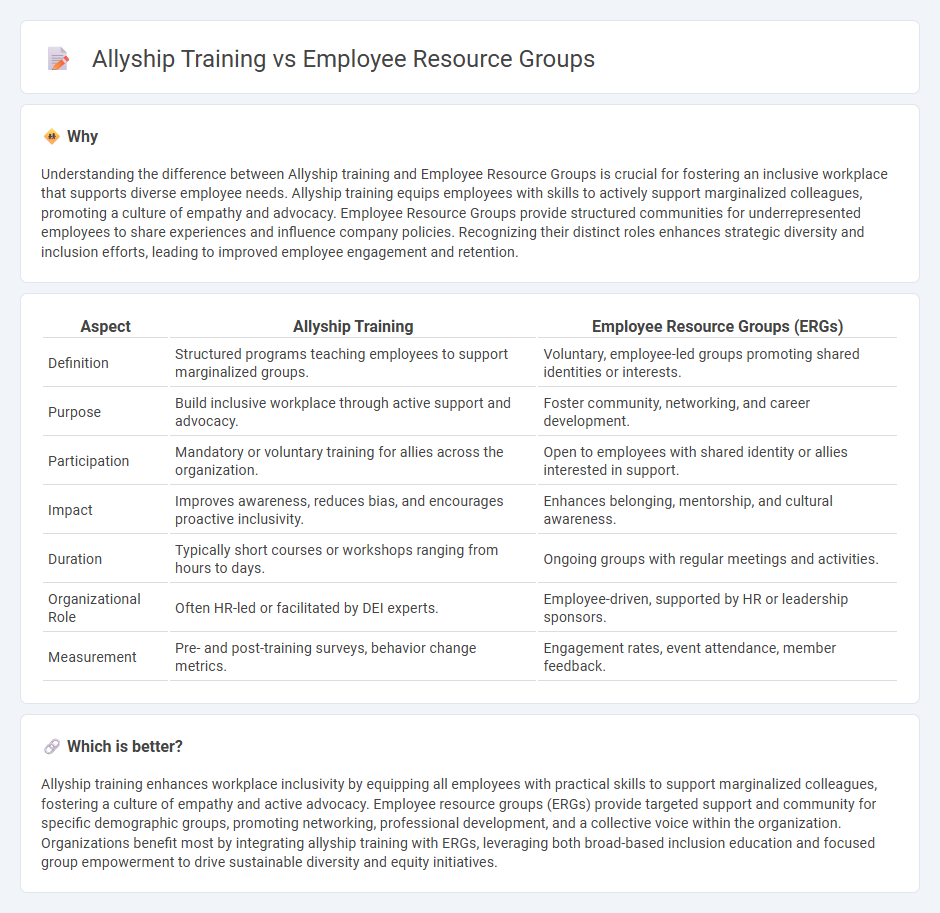
Allyship training empowers employees to actively support marginalized colleagues by fostering empathy, awareness, and inclusive behaviors, enhancing workplace culture and reducing bias. Employee Resource Groups (ERGs) provide structured communities for underrepresented groups to share experiences, drive professional development, and influence organizational policies. Explore how combining allyship training with ERGs can maximize diversity, equity, and inclusion outcomes in your organization.
Why it is important
Understanding the difference between Allyship training and Employee Resource Groups is crucial for fostering an inclusive workplace that supports diverse employee needs. Allyship training equips employees with skills to actively support marginalized colleagues, promoting a culture of empathy and advocacy. Employee Resource Groups provide structured communities for underrepresented employees to share experiences and influence company policies. Recognizing their distinct roles enhances strategic diversity and inclusion efforts, leading to improved employee engagement and retention.
Comparison Table
| Aspect | Allyship Training | Employee Resource Groups (ERGs) |
|---|---|---|
| Definition | Structured programs teaching employees to support marginalized groups. | Voluntary, employee-led groups promoting shared identities or interests. |
| Purpose | Build inclusive workplace through active support and advocacy. | Foster community, networking, and career development. |
| Participation | Mandatory or voluntary training for allies across the organization. | Open to employees with shared identity or allies interested in support. |
| Impact | Improves awareness, reduces bias, and encourages proactive inclusivity. | Enhances belonging, mentorship, and cultural awareness. |
| Duration | Typically short courses or workshops ranging from hours to days. | Ongoing groups with regular meetings and activities. |
| Organizational Role | Often HR-led or facilitated by DEI experts. | Employee-driven, supported by HR or leadership sponsors. |
| Measurement | Pre- and post-training surveys, behavior change metrics. | Engagement rates, event attendance, member feedback. |
Which is better?
Allyship training enhances workplace inclusivity by equipping all employees with practical skills to support marginalized colleagues, fostering a culture of empathy and active advocacy. Employee resource groups (ERGs) provide targeted support and community for specific demographic groups, promoting networking, professional development, and a collective voice within the organization. Organizations benefit most by integrating allyship training with ERGs, leveraging both broad-based inclusion education and focused group empowerment to drive sustainable diversity and equity initiatives.
Connection
Allyship training enhances understanding and support for underrepresented groups, which directly strengthens the effectiveness of Employee Resource Groups (ERGs) by fostering inclusive environments. ERGs rely on allyship principles to amplify diverse voices, promote equity, and drive organizational change. Together, they build a culture of belonging and collaboration within Human Resources frameworks.
Key Terms
Inclusion
Employee Resource Groups (ERGs) create dedicated spaces for underrepresented employees to connect and share experiences, fostering a sense of belonging and empowerment within organizations. Allyship training enhances inclusion by equipping coworkers with the skills to actively support marginalized groups, promoting awareness and behavioral change. Explore how integrating these initiatives can drive comprehensive workplace inclusion and equity.
Affinity
Employee resource groups (ERGs) foster affinity by creating safe spaces for employees who share common identities, promoting community engagement and support. Allyship training enhances workplace inclusion by equipping non-members with the skills to actively support and advocate for these groups, amplifying their impact. Explore how combining ERGs and allyship training can strengthen organizational culture and drive meaningful diversity initiatives.
Advocacy
Employee resource groups (ERGs) provide structured platforms for underrepresented employees to advocate for inclusive policies, fostering community support and empowerment within organizations. Allyship training educates all employees on proactive behaviors and verbal support strategies, emphasizing active participation in advocacy beyond mere awareness. Explore comprehensive approaches to integrating ERGs and allyship training to maximize advocacy impact in your workplace.
Source and External Links
Employee Resource Groups: Your Complete Guide - Indeed - Employee Resource Groups (ERGs) are voluntary groups formed around shared characteristics or interests, designed to promote diversity, inclusion, leadership development, cultural awareness, and professional growth within organizations, with four main types: diversity and inclusion, volunteer, affinity, and professional development ERGs.
Employee resource group - Wikipedia - ERGs, also known as affinity or business resource groups, provide workplace support and career development for employees based on shared characteristics or life experiences, and have expanded from traditional underrepresented groups to include interest-based groups like environmental advocacy and wellness.
Employee Resource Groups - CCDI Toolkit (PDF) - ERGs can be based on identity, shared values, or goals--covering cultural, faith-based, disability, gender, generational, environmental, mental health, and other groups--with terminology varying by organization, including affinity groups and business resource groups.
 dowidth.com
dowidth.com